Laboratori Nazionali di Frascati

The INFN National Laboratory of Frascati (LNF) was founded in 1954 with the objective of furthering particle physics research, and more specifically to host the 1.1 GeV electrosynchrotron, the first accelerator ever built in Italy. The Laboratory later developed the first ever electron-positron collider: from the first prototype AdA, which demonstrated the feasibility, to the ring ADONE and later on to DAΦNE, still operative today (2022). LNF was also the proposed site of the cancelled particle accelerator SuperB. Besides conducting experiments with their own facilities, the LNF researchers are also taking part in extensive collaborations at external laboratories, especially at CERN and in the United States. It is located in Frascati, Italy.
Excerpt from the Wikipedia article Laboratori Nazionali di Frascati (License: CC BY-SA 3.0, Authors, Images).Laboratori Nazionali di Frascati
Via Enrico Fermi,
Geographical coordinates (GPS) Address Phone number Website External links Nearby Places Show on map
Geographical coordinates (GPS)
| Latitude | Longitude |
|---|---|
| N 41.8207 ° | E 12.67313 ° |
Address
Istituto Nazionale di Fisica Nucleare – Laboratori Nazionali di Frascati (Laboratori Nazionali di Frascati)
Via Enrico Fermi 54
00044
Lazio, Italy
Open on Google Maps








